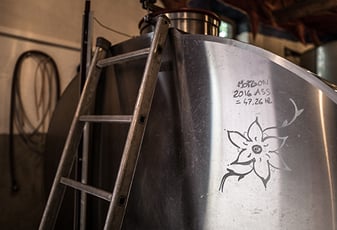What Is Carbonic Maceration and Why Do We Love It So Much?

With so much wine jargon in the world, getting a grasp on every technical term pertaining to vinification can seem impossible. However, there are a few key words that we think you should know-- and carbonic maceration is one of them. Known for producing fruit-forward, low tannin, and all-around easy-drinking wines, carbonically macerated fruit is responsible for producing some of our favorite bottles out there. So what exactly does that mean?
Basically, in the world of fermentation, yeast + sugar = alcohol, carbon dioxide, and heat. Normally, fermentation takes place in freshly pressed juice, after grape clusters are destemmed (or not) and crushed/pressed. However, with carbonic maceration, the process begins slightly before that.
Carbonic maceration allows fermentation to begin inside the actual berry itself, prior to the fruit being crushed/pressed. To execute this, full bunches of grapes are placed inside a sealed, carbon dioxide filled vessel. This lack of oxygen allows the fruit to begin fermenting intracellularly, meaning that fermentation actually begins inside each berry before the fruit is pressed. However, once the alcohol level reaches about 2%, the fruit begins to burst, releasing juice on its own, though more commonly, the winemaker will step in before this happens and begin pressing. Then, ‘regular’ fermentation follows suit, taking place in the pulpy, 2% ABV juice mixture that exists.
 📸: Verve Wine
📸: Verve Wine
So why are winemakers, industry professionals, and wine lovers abound so crazed by carbonically macerated wines? Simply put, they’re chuggable, easy-drinking, and delicious. Because of how the initial fermentation begins, the resulting wines are much lighter than ‘normally’ fermented red wines, showing significantly lower levels of tannins and a juicier, more fruit-forward flavor profile. Often described as poppy, crunchy, and bright, these wines are the ideal ‘chillable reds,’ perfect for sipping outside during the warmer spring and summer months.
Carbonic maceration is often synonymous with Beaujolais, as many producers within the region choose to vinify their Gamay in this way. However, with palate preferences beginning to gravitate towards lighter, higher-acid, the practice is becoming more common worldwide, particularly in other regions of France, Oregon, and California.
With pronounced aromatics, zesty acidity, and an all-around thirst-quenching nature, these poppy red wines are some of our favorite ‘pop and drink now’ bottles. Looking to dive deeper into the world of carbonic maceration? Here are some of our favorite producers working with this style of winemaking:
